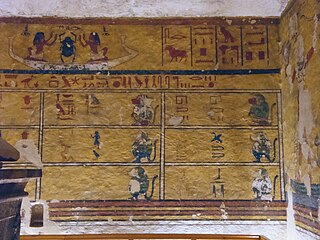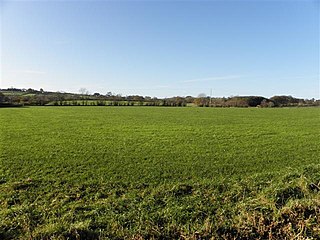Related Research Articles

A passage grave or passage tomb consists of one or more burial chambers covered in earth or with stone, and having a narrow access passage made of large stones. These structures usually date from the Neolithic Age, and are found largely in Western Europe. When covered in earth, a passage grave is a type of burial mound which are found in various forms all over the world. When a passage grave is covered in stone, it is a type of cairn.

A chamber tomb is a tomb for burial used in many different cultures. In the case of individual burials, the chamber is thought to signify a higher status for the interred than a simple grave. Built from rock or sometimes wood, the chambers could also serve as places for storage of the dead from one family or social group and were often used over long periods for multiple burials.

The court cairn or court tomb is a megalithic type of chambered cairn or gallery grave. During the period, 3900–3500 BCE, more than 390 court cairns were built in Ireland and over 100 in southwest Scotland. The Neolithic monuments are identified by an uncovered courtyard connected to one or more roofed and partitioned burial chambers. Many monuments were built in multiple phases in both Ireland and Scotland and later re-used in the Early Bronze Age.

A gallery grave is a form of megalithic tomb built primarily during the Neolithic Age in Europe in which the main gallery of the tomb is entered without first passing through an antechamber or hallway. There are at least four major types of gallery grave, and they may be covered with an earthen mound or rock mound.

Beaghmore is a complex of early Bronze Age megalithic features, stone circles and cairns, 8.5 miles north west of Cookstown, County Tyrone in Northern Ireland, on the south-east edge of the Sperrin Mountains.

Dunamuggy is a townland of 172 acres in County Antrim, Northern Ireland. It is situated in the civil parish of Donegore and the historic barony of Antrim Upper.

Legananny Dolmen is a megalithic dolmen or cromlech nine miles southeast of Banbridge and three miles north of Castlewellan, both in County Down, Northern Ireland. It is on the slopes of Slieve Croob near the village of Leitrim, in Drumgooland parish, nestled between the farmer's stone wall and a back road. It is a State Care Historic Monument sited in the townland of Legananny, in Banbridge District, at grid ref: J2887 4339.
This article describes several characteristic architectural elements typical of European megalithic structures.

Tievebulliagh is a 402-metre-high (1,319 ft) mountain in the Glens of Antrim, Northern Ireland. It forms part of the watershed between Glenaan to the north and Glenballyemon to the south. It is situated about 4.4 km from Cushendall.

Ballylumford Dolmen is situated on Islandmagee, County Antrim, Northern Ireland, near the north-west tip of the Islandmagee peninsula and near Ballylumford power station. It is known locally as the "Druid's Altar", and could be 4000 years old, or the remains of an even earlier passage grave. The dolmen consists of four upright stones, with a heavy capstone and a fallenstone within the structure. This may have been put there to block the entrance to the tomb. The dolmen is in the front garden of a house. A wall plaque at the site describes the dolmen as a single chambered grave erected about 2000-1600 BC. Local finds indicate occupation of the neighbourhood during the Bronze Age.
Craigs Dolmen is situated three miles north of Rasharkin, County Antrim, Northern Ireland, close to a minor road, at a height of 200m on the Long Mountain. Craigs Dolmen passage tomb is a State Care Historic Monument in the townland of Craigs, in Borough of Ballymoney, at grid ref: C9740 1729.

Aghanaglack or Aghnaglack, is a townland in County Fermanagh, Northern Ireland. It is situated in the civil parish of Boho, as well as Fermanagh and Omagh district.
Aghalislone is a townland of 664 acres in County Antrim, Northern Ireland. It is situated in the civil parish of Derriaghy and is split between the historic Baronies of Massereene Upper and Belfast Upper.

Ault,, is a townland of 367 acres in County Antrim, Northern Ireland. It is situated in the civil parish of Tickmacrevan and the historic barony of Glenarm Lower.
References
The main reference for all sites listed is: NI Environment Agency, Scheduled Historic Monuments (to 15 October 2012), unless otherwise indicated.
- 1 2 3 4 5 6 7 8 9 "State Care Historic Monuments" (PDF). Environment and Heritage Service NI. Retrieved 14 December 2007.
- 1 2 3 4 5 6 7 8 9 "Scheduled Historic Monuments" (PDF). Environment and Heritage Service NI. Archived from the original (PDF) on 5 November 2008. Retrieved 14 December 2007.
- 1 2 3 4 5 "County Antrim - Heritage/Historical". Go Ireland.com. Archived from the original on 21 November 2007. Retrieved 14 December 2007.